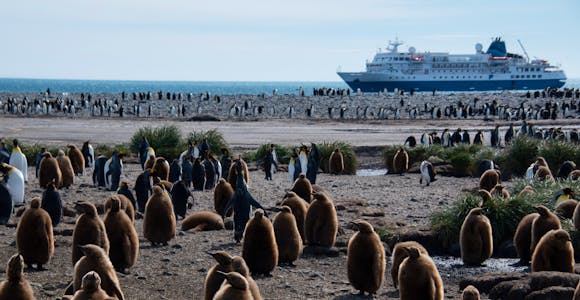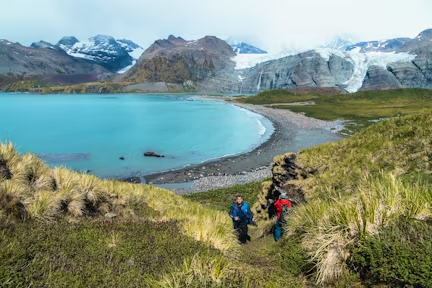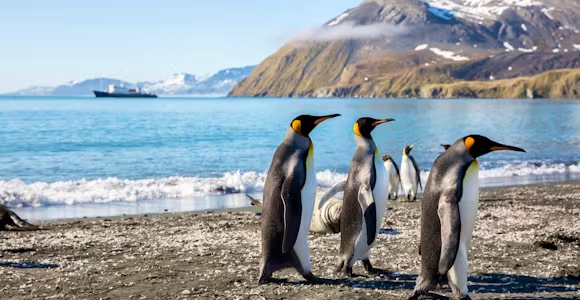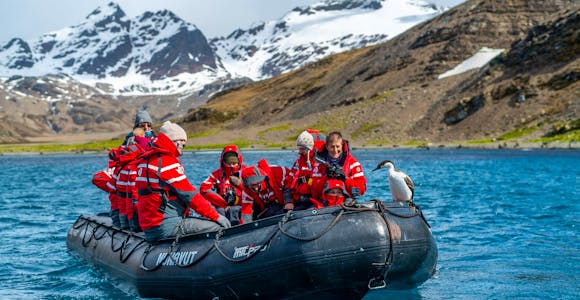
Getting to South Georgia Island
Deep in the Southern Ocean some 870 miles from its nearest neighbour, South Georgia is more challenging (and exciting) to get to than almost anywhere on earth.
Discover More
King penguins on the beach at St Andrews Bay
South Georgia may be tiny, but it punches far above its weight to offer a wildlife experience like no other. Seals, penguins and other seabirds are counted in the millions: at the height of the breeding season, nowhere else on Earth has such a density of wildlife.
Four species of penguin breed here: gentoos, chinstraps and macaronis, along with the majestic king penguins whose epic colonies are one of the islands biggest attractions. Albatrosses wheel overhead, while you can listen out for the distinctive song of the South Georgia pipit, the world's most southerly songbird, whose numbers are in resurgence after rats were eradicated in 2018.
On the beaches, as many as fur seals crowd the shores, while giant male elephant seals lord it over their harems. In some locations in high summer, the sheer density of seals can make beach landings near impossible. South Georgia's waters are rich feeding grounds for whales.
Although their numbers were devastated by the whaling industry in the last century, humpback whale numbers have almost completely recovered around the island, with fin whale numbers also increasing. Blue and southern right whales remain rare sights. >

The hike to Gold Head viewpoint above Gold Harbour
South Georgia is spectacularly picturesque. The island is almost completely dominated by a dragon's spine of the Allardyce and Salvesen Mountain ranges that rise straight out of the ocean. Over half the island is permanently covered in snow and glaciers. The highest peak in South Georgia is Mount Paget (2934m/9626 feet). The coastline is crinkled with many fjords and bays that offer sheltered spots for ships to anchor.
There are no trees on South Georgia. In snow-free areas the landscape is dominated by tussock, grassland and peaty bogs. Tussock in particular forms an important breeding location for many bird species, as well as muddy wallows for elephant seals.
Several landing sites are dominated by large glacial outwash plains. These areas are increasing due to South Georgia's fragility in the face of climate change. Some 97% of the islands glaciers that previously terminated in the sea have retreated in the past 50 years. Ironically, this has increased the breeding areas available to species like king penguins, whose numbers have grown in the corresponding period.
Like many small islands South Georgia is highly susceptible to introduced species. In recent years the South Georgia Heritage Trust successfully oversaw a largescale project to eradicate rats, as well as the reindeer that had been introduced by whalers and were overgrazing native plants. A project to control introduced plant species is ongoing.

The abandoned whaling station at Stromness Harbour
The history of this small island is no less intoxicating than the wildlife and scenery, steeped as it is in the history of both Antarctic exploration and the earlier sealers and whalers.
South Georgia appeared on maps with the first sighting in 1675 by London merchant Antoine de la Roche. Then in 1775 Captain James Cook circumnavigated the island and made the first landing, claiming the territory for Great Britain, thereby beginning a long relationship which continues to this day.
Passing observations made in Cook’s reports of significant numbers of fur and elephant seals attracted the unwanted attentions of 18th-century sealers who triggered the first bloody chapter in the island’s history. By the 1830’s the fur seal population had been decimated almost to the point of collapse, leading to the decline of the unchecked sealing industry itself.
This wasn’t the last time though that South Georgia’s natural bounty would fall foul to commercial gain. The establishment of the first land-based whaling station at Grytviken in 1904 provided whalers with their first toe-hold on the island, after which operations expanded with further stations, and it became a base for whaling operations.
Fuelled by Europe’s growing appetite for the oils that whales could provide - mostly for margarine and soap - the whalers headed south. It's estimated the subsequent bonanza over six decades led to approx.1.6 million whales being killed in the Southern Ocean. It wasn’t until 1965 that the whaling stations doors were finally closed forever and left to decay.
Price Match Promise - We’ll match any price you find elsewhere for the same trip
South Georgia trips scored 4.5/5 from 216 reviews
As South Georgia doesn’t have enough flat land for an airport, all visitors must arrive by sea. Under usual sea conditions it takes two days to sail to South Georgia from the Antarctic Peninsula, or just over a day from the Falkland Islands.
The closest airport to South Georgia is at Stanley on the Falkland Islands – a small number of voyages may start here, involving a flight to the islands from Punta Arenas in Chile.
For more information see our page Getting to South Georgia.
The visitor season runs from November to March. There isn’t a ‘best time’ to visit as such because South Georgia is such a wildlife dense destination, and you may want to balance the timing with your preferred time to be on the Antarctic peninsula. It's worth noting however that thanks to their unusual breeding cycle, fluffy king penguin chicks will be present whenever you visit.
For more information see our page When to go to South Georgia.
The weather is very windy and variable, and it's more than possible to experience all four seasons in a day. Summer temperatures between November and March, range from 1 to 8°C. The characteristics of the island are very telling of the climate; with 75% coverage of permanent snow and ice.
There’s no accommodation on South Georgia, which is why people visit by expedition ship or the occasional intrepid and self-sufficient yacht.
No – you don’t need a visa to visit South Georgia. Visitor permits are automatically arranged for you if arriving by cruise ship.
Yes – all visitors have their passport stamps when they arrive in Grytviken. This is automatically arranged for you by the team on your expedition cruise ship.

Deep in the Southern Ocean some 870 miles from its nearest neighbour, South Georgia is more challenging (and exciting) to get to than almost anywhere on earth.
Discover More
Numbers alone simply can’t explain how extraordinarily abundant and breathtaking the wildlife of South Georgia is: this is the Serengeti of the Southern Ocean
Discover More
Walk across South Georgia's spectacular landscape, go ashore to meet the abundant wildlife or learn about the island's rich history.
Discover More
The Falkland Islands are a small, remote and thinly populated archipelago that punch well above their size when to comes to amazing wildlife and scenery.
Discover MoreWe'll spend some time listening to your aspirations, then discuss the kind of experience that might suit you.
Next we'll discuss the options, shortlist the best trips for you and present you our impartial recommendations.
We'll place a 24 hour hold on your preferred option - without obligation - whilst we talk through the details.